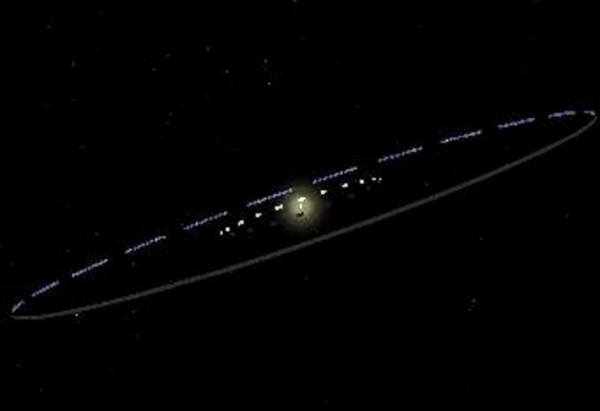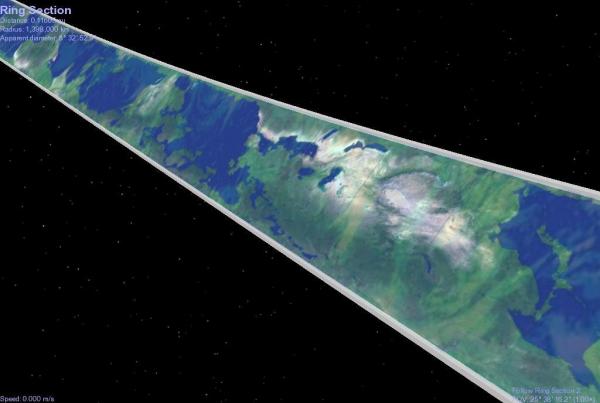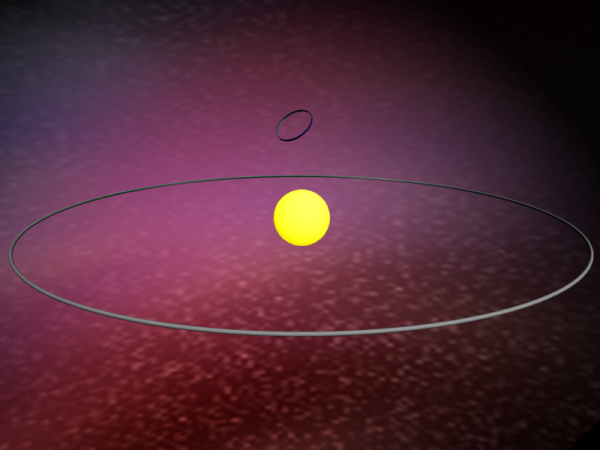BY LETTER
Ringworlds
Technology > Application > Construction
Technology > Application > Infrastructure
Technology > Application > Megascale Engineering
Technology > Application > Infrastructure
Technology > Application > Megascale Engineering
Circumstellar Rotating Megastructures |
 Image from Copyright Lilly Harper |
The star is continually overhead when seen from the surface of such a structure. A day-night cycle, if desired, can be provided by sunshades of various kinds. The size of a Banks Orbital is determined by the combined factors of the desired length of its day/night cycle and the desired gravity. The size of a ringworld is determined by the amount of insolation desired on its surface. Around Sol, with Earth like conditions on its surface, this would give a ringworld with a maximum diameter slightly bigger than the orbit of Mars.
Instability
Ringworlds completely encircle a star and are inherently unstable. Any force acting on it, such as gravity from a planet or a coronal mass ejection (CME) will cause it to drift toward the star and eventually collide with it. Fortunately such forces are very small and various stabilization methods are used to maintain its position. Solar sails placed around its circumference are one possibility. The acceleration from the solar sails can be used to balance any small gravity perturbations from a planet orbiting the star with the ringworld. Thrusters can also be used in the same way. Using ramscoop technology to collect the solar wind provides the thrusters with cheap fuel. Alternately reactionless drives can be used, negating the fuel requirements, thus simplifying this part of the ringworld's construction. Long cables can be strung from its circumference to the star. The cables can then be magnetically coupled to the star's magnetic field, holding the ringworld in place. Image from John M. Dollan |
Day/night cycle
The habital inner surface of a ringworld always faces its star and the day/night cycle (if nights are desired) must be controlled by blocking the light from the star. This can be accomplished by placing orbiting structures between the star and the ringworld, creating night when the light is blocked; these structures can be arranged in many different configurations, and usually double as a power collection swarm.Size
A ringworld's size is determined by the amount of insolation desired on its surface and the amount of material available for its construction. For a ringworld with Earth like conditions on its surface it must orbit within its star's habitable zone. For a Sol-like star this gives a diameter between 200 and 500 million kilometers. Its maximum width can be as large as the stars diameter, but is usually much thinner, availability of material generally being the determining factor.The first ringworlds were constructed around cool white dwarf stars, and used orbital ring technology instead of magmatter- see the article on Wadai, the first such structure.
Construction
Construction of a ringworld requires large amounts of material and energy. A ringworld circling its star at 1AU, 10 000 km wide will require1.3e25 kilograms of magcarbon buckytube fibres (a layer a few micrometers thick) requiring 1.2e42 joules of energy to create (approxiamately the mass/energy of 2.2 Earth size planets)
7.2e23 kilograms of nickel-iron
2.6e25 kilograms of foamed diamondoid.
2.6e25 kilograms of corundumoid, silicates, carbon, and other minerals
9.7e23 kilograms of water
Apart from the energy required to construct the ring and to manufacture the magmatter, the ringworld itself requires a very large amount of rotational energy; this amount alone is equal to about 20,000 years of a Sun-like star's output.
 Image from Steve Bowers |
Tides
A ringworld experiences a balanced gravitational attraction all around its circumference; its terraformed inner surface experiences no tides. This is a factor only when determining what kinds of life will fill its biosphere. Any organisms that require the intertidal environment cannot be a part of the biosphere without engineering artificial tidal system that displaces water into and out of a lake or sea. A variant of angelnet can manage this in some cases by creating large volume bubbles in the seas. In some cases a lower technology solution is used where large cavities in land or sea mounts are alternately pressurized displacing water out through a tunnel at the bottom into the sea. The total volume of these caves are equal to the area of the sea times the intended tide range; generally many cubic kilometers in total. Since these are dark chambers they double as simulations of deep ocean environments. Some have nanofabricators that drop food down into these deep dark seas. Ringworlds should not be confused with the Banks Orbital concept, a much smaller (but still very large) ring-like megastructure that orbits the star like a planet and is tilted to provide a day night cycle. Construction materials and techniques used in a Ringworld are very similar to those used in a Banks Orbital. A typical Banks Orbital is three or four million kilometres in diameter, while a ringworld may be hundreds of millions of kilometres in diameter. However, several smaller ringworlds have been constructed around red dwarf stars and white dwarf stars, and many of these smaller ringworlds are similar in scale to a typical Bank's Orbital.
Related Articles
Appears in Topics
Development Notes
Text by Ron Bennett
Initially published on 26 March 2013.
Initially published on 26 March 2013.
Additional Information
Image 'Ringworld' copyright by Lilly Harper used with permission. Please contact her for conditions of re-use at https://beaconsinthedark.wordpress.com/.







